
Milan Cathedral, or Metropolitan Cathedral-Basilica of the Nativity of Saint Mary, is the cathedral church of Milan, Lombardy, Italy. Dedicated to the Nativity of St. Mary, it is the seat of the Archbishop of Milan, currently Archbishop Mario Delpini.
Arnulf III was the Archbishop of Milan from his election on 6 December 1093 to his death in 1097. He succeeded Anselm III only two days after his death. Along with Anselm III and Anselm IV, he was one of a trio of successive archbishops of Milan to side with pope against emperor in the late 11th and early 12th century.

Antonio d'Enrico, called Tanzio da Varallo, or simply il Tanzio was an Italian painter of the late-Mannerist or early Baroque period.

San Marco is a church in Milan, northern Italy.

Santa Maria del Carmine is a church in Pavia, Lombardy, northern Italy, considered amongst the best examples of Lombard Gothic architecture. It was begun in 1374 by Gian Galeazzo Visconti, Duke of Milan, on a project attributed to Bernardo da Venezia. The construction followed a slow pace, and was restarted in 1432, being finished in 1461.

The Oratorio di San Protaso is a church in via Lorenteggio, Milan, Lombardy.
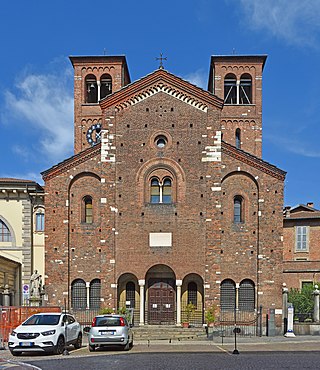
Chiesa di San Sepolcro is a church in Milan, Italy. It was originally built in 1030, but has undergone multiple revisions. The church is located at Piazza San Sepolcro in the historic center of Milan.
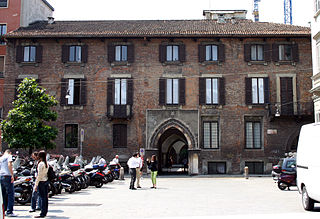
Palazzo Borromeo is a 14th-century building located at piazza Borromeo 12 in Milan, region of Lombardy, Italy. It was built as the home and business headquarters of the Borromeo family, merchant-bankers from Tuscany. Some of the building complex was badly damaged during World War II in Allied bombings of 1943 but was reconstructed and restored to its 15th-century appearance. It contains an important fresco cycle from the 1440s and is one of the finest examples of a Milanese patrician palace from the early Renaissance.

The Palazzo delle Scuole Palatine is a historic building of Milan, Italy, located in Piazza Mercanti, the former city centre in the Middle Ages. It served as the seat of the most prestigious higher school of medieval Milan. Many notable Milanese scholars of different ages studied or taught in these schools; Augustine of Hippo and Cesare Beccaria, among others, served as teachers in the Palatine. The current building dates back to 1644, when it replaced an older one, which had the same function and was destroyed by a fire.

Neoclassical architecture in Milan encompasses the main artistic movement from about 1750 to 1850 in this northern Italian city. From the final years of the reign of Maria Theresa of Austria, through the Napoleonic Kingdom of Italy and the European Restoration, Milan was in the forefront of a strong cultural and economic renaissance in which Neoclassicism was the dominant style, creating in Milan some of the most influential works in this style in Italy and across Europe. Notable developments include construction of the Teatro alla Scala, the restyled Royal Palace, and the Brera institutions including the Academy of Fine Arts, the Braidense Library and the Brera Astronomical Observatory. Neoclassicism also led to the development of monumental city gates, new squares and boulevards, as well as public gardens and private mansions. Latterly, two churches, San Tomaso in Terramara and San Carlo al Corso, were completed in Neoclassical style before the period came to an end in the late 1830s.
Landulf of Saint Paul, called Landulf Junior to distinguish him from Landulf Senior, was a Milanese historian whose life is known entirely from his main work, the Historia Mediolanensis. He presents a unique and important point of view from the conflict-ridden years of 1097–1137 in Milan. He thrice sojourned in France while his ecclesiastical faction—the Pataria—was out of favour in Milan, and there learned under some of the leading philosophers of western Europe. After 1113, Landulf's primary ambition was to regain the priesthood in the church of San Paolo which he had lost, and to this end he communicated with popes and emperors. He played a role—large in his own account—in the election of Conrad of Hohenstaufen as King of Italy in 1128.

Pietro Maggi was an Italian painter of the late-Baroque period.
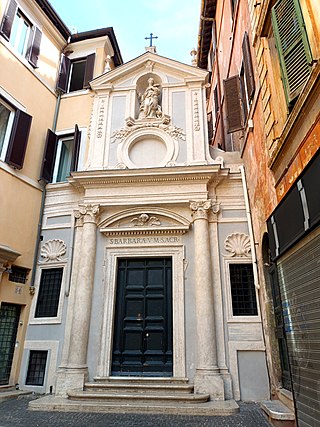
Santa Barbara dei Librai is a small Roman Catholic church in Rome, Italy. It was once known as Santa Barbara alla Regola after the rione in which it was located. Today it now considered within the rione of Parione, near the Campo de' Fiori.
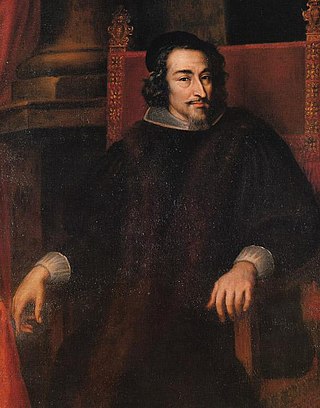
Bartolomeo III Arese count of Castel Lambro born in Milan on 23 October 1590 and died in the same city on 23 September 1674 was an Italian nobleman, politician, and prominent member of the House of Arese.
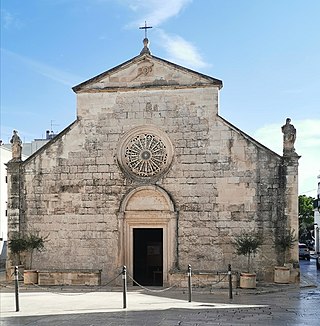
The Church of Madonna della Greca is the oldest church in Locorotondo, Apulia, Italy, and it is completely dedicated to Santa Maria della Greca. It was first built between the 7th and 8th century and then reconstructed in the 15th century.

The Cathedral of Our Lady of the Snows is the main place of Roman Catholic worship in Nuoro, Sardinia, and the cathedral church of the diocese of Nuoro.

The Palazzo del Monte di Pietà is a 15th-century palazzo in Milan, Italy, adapted in a neoclassical style in the 18th century by Giuseppe Piermarini. Historically belonging to the Sestiere di Porta Nuova, it is located in Via Monte di Pietà no. 5, and was the seat of the Monte di Pietà di Milano.
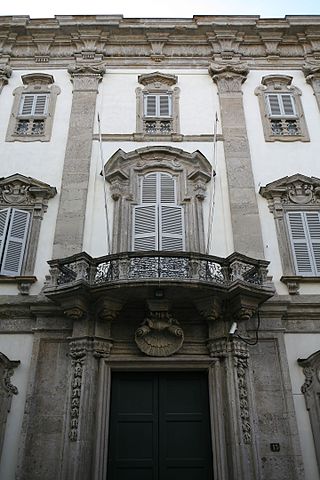
Palazzo Cusani is a 17th-century palace in Milano, remodelled a first time between 1712 and 1719 and a second time between 1775 and 1779. Historically belonging to the sestiere of Porta Nuova, it is located at via Brera 13–15.

Gothic art in Milan denotes the city's artistic period at the turn of the second half of the 13th century and the first half of the 15th century. The Gothic style, initially introduced into Milanese territory by Cistercian monks, was the main artistic style of the vast patronage and self-celebrating agenda of the Visconti family, lords of Milan, whose rule over the city is usually associated with the Milanese Gothic period.




















